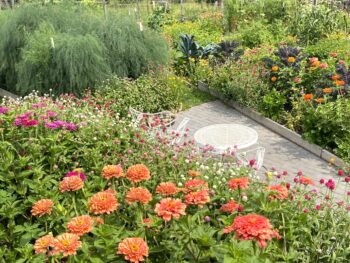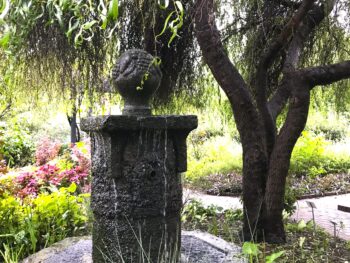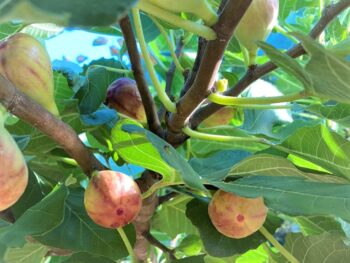Myrtle is a veiled treasure from the Bible, one I was delighted to discover in researching God’s Word for Gardeners. Though overshadowed in internet searches by crape myrtles, a botanically unrelated plant, myrtle is abundant in the Mediterranean region and widely adapted Arizona and Southern California as another water savvy plant. Myrtle endures scant water situations, though it grows more floridly in water-full niches and ravines in the landscape. See the beauty of this evergreen exclusive in the Plant Guide to enjoy growing in your garden.
 Topiary Success
Topiary Success
Don’t dismiss the plant if you are a northern gardener; you, too, will have success! ‘Compacta’ varieties are available and make excellent choices for container growing, forming, and shaping: Train myrtle as a topiary, its glossy, evergreen fragrant leaves a joy to tabletops and patio planters.
Wedding Bouquets
My favorite unearthing in myrtle’s history and lore is its use as wedding boughs, perhaps a tradition after Queen Esther’s marriage (Esther 2:17-18 ), her original name a derivative of myrtle. In more modern times, Queen Victoria planted a myrtle tree, and sprigs were included in her daughter’s wedding bouquet–the same tree lent greenery to Princess Kate’s wedding flowers! Cut branches remain fresh and vibrant throughout a long wedding day, and signify the everlasting qualities of the marriage blessing.
…instead of briers the myrtle will grow. This will be for the Lord’s renown, for an everlasting sign, that will endure forever
Isaiah 55:13 NIV
“We beseech thee, O LORD, do prosper us!”*
Myrtle branches are the second of four species used in the Feast of Tabernacles celebration, the “Season of our Gladness.”* Its horticulture –vibrant, evergreen leaves with sweet, bright white blossoms–conveys the triumphant rejoicing and gladness of this festive occasion, expressed in the exiles return to their Holy Land and their joys at being refreshed with the traditions of their heritage:
Nehemiah said, “Go and enjoy choice food and sweet drinks, and send some to those who have nothing prepared. This day is holy to our Lord. Do not grieve, for the joy of the Lord is your strength”…They found written in the Law, which the Lord had commanded through Moses, that the Israelites were to live in temporary shelters during the festival of the seventh month…“Go out into the hill country and bring back branches from olive and wild olive trees, and from myrtles, palms and shade trees, to make temporary shelters”—as it is written.
Nehemiah 8:10, 14-15
Paired with the celebratory, salvation cry, “Hosanna!” in Jewish tradition, myrtle branches mirror the petition for success, pleas for victory and prosperity, in the sweet savor of their fragrance and endurance.
This is the day which the Lord has made; let us rejoice and be glad in it.
Save us, we beseech thee, O Lord!
O Lord, we beseech thee, give us success!
Psalm 118:24-25 RSV
And they reported to the angel of the Lord who was standing among the myrtle trees…. Then the angel who was speaking to me said…“Proclaim further: This is what the Lord Almighty says: ‘My towns will again overflow with prosperity
Zechariah 1:11, 14, 17 NIV
Myrtle is now a part of our Plant Guide
www.gardeninDelight.com/plant-guide/myrtle
* taken from Sabbath and Festival Prayer Book (The Rabbinical Assembly of America and The United Synagogues of America, 1946), page 115
Photo Credits: ©2015 Shelley S. Cramm A blossomed bough of dwarf myrtle from the Huntington Botanical Gardens in Southern California
© 2010 Kavram | Dreamstime.com – The Branches Of The Myrtle Photo – The branches of the plant to the ritual Jewish religious holiday of Sukkot















